How Effective Performance Management Can Transform Your Business
Last Updated on September 6, 2022 by Owen McGab Enaohwo
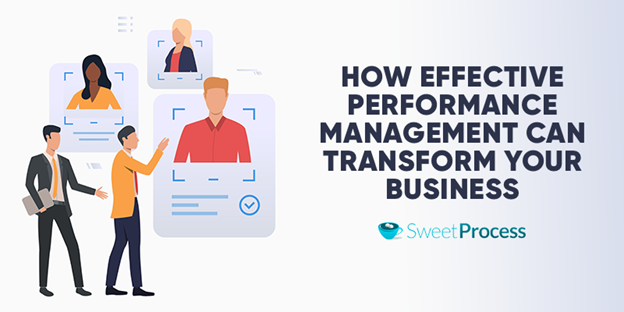
Creating and implementing a performance management system can be a daunting task. But, with the right tools and planning, it can be an incredibly effective way to improve your business.
Research has shown that highly engaged businesses experience 59 percent less turnover. Also, when an employee feels that their voice is being heard, they are 4.6 times more likely to feel empowered to put in their best performance.
How then do you ensure that your performance management is top-notch and help you maintain a solid and highly motivated workforce?
In this in-depth guide, we’ll walk you through the steps to create a system that will help you achieve your goals.
We’ll also provide tips on effectively managing your employees’ performance, cutting down on redundancy, and reducing employee turnover.
Performance Management Guide – Chapter Index
Chapter 1: What is Performance Management?
Chapter 2: Performance Management Process
Chapter 3: Types of Performance Management
Chapter 4: The Era of Automated Performance Management
Chapter 5: How SweetProcess Can Enhance Your Performance Management Process
Chapter 1: What is Performance Management?

Performance management refers to the set of procedures that identifies special measures and helps improve an employee’s performance to meet organizational goals.
It assists in boosting management/employee relationships as well as builds a high-performance workplace.
Performance management involves a systematic process that monitors and supervises specific departments or employees’ roles to ensure they meet and achieve all organizational goals efficiently and effectively.
This powerful tool pushes employees to be motivated and more productive to enhance their competencies and skills.
Performance management is an ongoing process, beginning with the job and only ending after the employee leaves the company. You can apply performance management to a team collectively or an individual employee.
Competition in business is grueling and challenging in the current working scenario. Globalization may have contributed significantly to the increased business opportunities.
But it has also resulted in a considerable increase in the complexities of tracking the workforce’s overall performance, often brought together from several organizational cultures.
These cultures compelled many organizations to hire human resource specialists who assist companies in recruiting employees, monitoring each employee’s progress, and retaining only the best ones.
The role of human resources (HR) is continually evolving and focuses on active participation and employee engagement. According to an expert, the business world has become more virtual, high-tech, and constantly changes and moves. Management has no choice but to be much more personal in dealing with employees.
The performance management process or system comes into play to make the HR specialist’s job simpler. The primary reason it gains momentum is due to its strategic and integrated approach.
Performance management remains the tool that helps workers remain highly motivated. They also progress in manners that align with the mission of the organization.
What is the goal of performance management?
Performance management is an ongoing process that helps increase productivity and engagement and reduce performance problems.
It aims to improve performance by identifying, training, and developing employees and encouraging them to take responsibility for their performance.
You can conduct performance management through formal or informal processes that allow performance improvement over time.
Understanding performance management
Performance management involves the process empowering workers to improve their performance, providing feedback on how they are doing, and providing clear job responsibilities.
It involves aligning employees’ individual goals with organizational goals so that both can succeed.
It ensures that every employee is performing at their optimum efficiency, output, or level of service. Performance management might be described as “the way we do things around here.”
Performance management practices are the methods used to measure how well employees are doing their jobs, and using their knowledge and skills to improve their performance.
What is the difference between performance management and performance appraisals?
Performance management is a process of monitoring, measuring, and managing an individual’s performance throughout the year. Performance appraisal is done at least once a year for employees who have their performance managed for them.
Performance appraisal determines if goals were met, what areas need improvement, and how to improve on these things. Performance management can be applied to all employees, while performance appraisal is only used on employees to manage their performance.
Advantages and disadvantages of performance management
As with every process, you should consider its merits and demerits.
Advantages of performance management
- Performance management allows the opportunity to provide workers with constructive criticism and feedback.
- Processes such as providing feedback allow companies to retain top employees because employees feel their opinions matter and are valued team members.
- Performance management is critical to creating a productive work environment and establishing clear job descriptions and expectations.
Disadvantages of performance management
- Performance management is not effective for employees performing poorly or struggling with their jobs. Performance management can be time-consuming and expensive because it requires managers to implement the processes.
- It only works if employees are willing to discuss their performance openly and honestly with their supervisors, which is not always the case. Performance management could create an environment where employees feel constantly being watched and become nervous about doing their jobs well.
- Performance management policies are often ignored if they are not followed up on by managers.
Performance Management Programs
Performance management encourages continuous learning and development of employees through performance improvement plans. Performance management programs involve regularly scheduled reviews, intending to provide feedback to employees about their work and help them grow and improve in their jobs.
It is used by organizations interested in having a team of highly motivated employees who can meet company goals and objectives.
Performance management allows companies to retain top talent because employees feel their opinions matter, and that they are valued members of the team.
Performance management is critical to creating a productive work environment and establishing clear job descriptions and expectations.
In the next chapter, we’ll uncover the performance management cycle and how it drives growth in your business.
Chapter 2: Performance Management Process
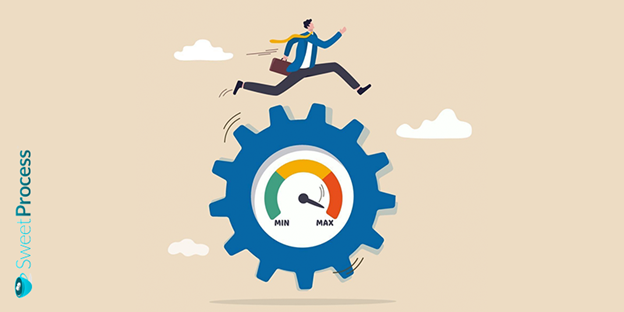
As the name suggests, the performance management process is a process that helps organizations maintain and improve their employees’ performance levels. It manages and controls all aspects related to the performance and productivity of the employee.
Performance Management Cycle
The performance management cycle is a performance management strategy or process segment.
This model runs traditionally on a year-long timeline and ends with a performance review. However, some companies have discovered that more frequent check-ins significantly improve employee performance.
Let’s take a closer look at every stage of the performance management cycle.
What are the stages of the performance management cycle?
The performance management cycle is generally shorter and employs a continuous four-step procedure: planning, monitoring, reviewing, and rewarding.
Utilizing this method includes higher employee motivation, increased competitiveness, and more structural flexibility.
Planning
Planning is the first step when it comes to the performance management cycle and is the foundation for effective processes. This stage includes:
- Outlining plans for evaluations
- Setting objectives
- Obtaining commitment activities
Planning is an ongoing process in performance management, and it should be carried out with SMART goals. It helps promote understanding and commitment by connecting the employees’ work with the organization’s objectives and goals.
This phase also involves communicating the vision of the organization and working toward achieving that vision as a whole.
Monitoring
Monitoring is an action-driven step that involves accomplishing the larger organizational goal. It involves consistent measurement of performance and providing continuous feedback to employees toward achieving their primary goal.
Monitoring also includes maintaining positive approaches to work, providing honest feedback to a supervisor, requesting genuine feedback from a supervisor, supervisors and employees working together, and suggesting vital career development exercises.
In other words, this stage enhances communication within a company for workers to be aware of goals and contribute significantly to future development.
Reviewing
Reviewing involves assessing the milestones a particular worker has achieved toward their set objectives. The growing trend of this era is the ongoing approach to reviewing the overall performance of an employee.
It is crucial to keep the entire process of giving and receiving feedback accessible and simple to keep the conversation real-time.
It is also essential to ensure that this process of nudging and requesting feedback is user-centric and easy. This makes the employee the valid owner of the process.
Technology is an ever-evolving landscape and a hotspot in recent years. You can now leverage technology effectively to enable workers to share feedback anonymously and instantly.
In the few instances where sharing critical feedback is somewhat reserved, employees can do so securely by using highly configured systems.
Rewarding
This last phase of the performance management cycle involves rewarding performance. It has to do with recognizing and compensating hard-working employees for excellent performance.
Gone are the days when rewards used to work in silos. It now operates in conformity with one’s compensation and performance. It also encourages you to celebrate a culture of recognition and appreciation by fostering an engaged workforce.
Rewarding helps demonstrate and build dynamic relationships between employers and employees. However, compensation is very much far from being the only essential factor.
The most appreciated factor is a 360-degree reward strategy as it can build and recognize a career path, attack talent, and enhance employee productivity simultaneously. This helps in employee motivation and retention.
The New, Continuous Performance Management Cycle
Prominent organizations such as Adobe, Deloitte, General Electric, and Microsoft have adopted the doctrine of continuous performance management since 2015.
Each of these household brands has completely abandoned conventional annual performance reviews in preference to frequent real-time feedback and regular check-ins.
The regular performance discussions are generally future-focused and developmental.
They offer team members the opportunity to explore what went well and how they can easily replicate the success and agree on measures that both the manager and individual must take to develop and promote their performance.
It also handles any challenges they are currently encountering and how they can overcome the challenges encountered by team members.
These check-ins are also an excellent way of addressing employee development while providing training opportunities and regular enforcement of performance expectations.
Chapter 3: Types of Performance Management

Performance appraisal terms vs. their real meaning
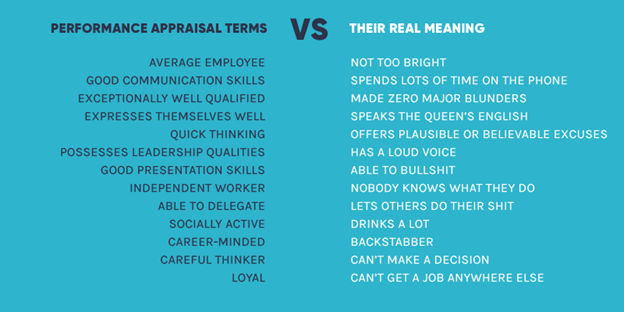
Performance Appraisal: How to Reward, Recognize, and Encourage Strong Performance
The first thing that usually comes to mind as ways to reward and motivate good performance is financial rewards such as bonuses and merit increases.
But if financial rewards are unavailable or limited, business owners start wondering what to turn to. This is when they start asking themselves questions like:
- “How exactly can I motivate my employees to do excellent work?”
- “How can I demonstrate my recognition of strong and impressive performers with rewards that ensure they all remain engaged and focused toward the greater good of the organization?”
In-depth research reveals that past a certain threshold, using money as a reward for outstanding performance at work may have the opposite effect on your team, since it is an extrinsic reward.
Obviously, well-compensated employees will perform better than underpaid ones, but intrinsic rewards are considered the most powerful motivators. Beyond a paycheck, the utmost satisfaction of making meaningful progress toward accomplishing significant objectives and its personal enjoyment are proven long-term motivation drivers.
Research also shows that solid performers are more likely to be motivated with greater authority, support for advancement, coaching, and feedback.
Here are some specific ways to keep them motivated, affirm the performance of solid performers, and ensure job satisfaction:
Coaching and feedback
One of the most significant performance drivers is regular feedback. This is how employers help employees progress toward their priorities and goals daily.
When coaching and feedback help individuals make meaningful progress, it creates engagement and motivation. Therefore, coaching and feedback should address negative and positive behaviors at different periods.
Be as specific as possible about behaviors. Explain why a specific behavior was ineffective or effective. Describe the specific situation, the resulting behavior, and the overall impact of the behavior on progress toward goal accomplishment.
Therefore, you can ask yourself these questions:
- “What kind of review or feedback do I give my employees?”
- “How often do I give that feedback? How do I know if the feedback is effective or ineffective?”
- “How do I know my feedback is timely, fair, and specific?”
- “How often do I discuss overall performance and provide feedback to staff and faculty?”
Stretch assignments
Setting meaningful objectives and making tangible progress toward them evokes engagement and feelings of satisfaction. It can also be very motivating.
This is why you should talk with every employee to find out their professional interests. The goal is to work with them to create challenging goals that align with the employees’ professional interests.
Meaningful and challenging goals will require employees to tap into their internal motivations to accomplish their goals.
So, ask yourself the following questions:
- “What exactly do my employees find most fulfilling and challenging about their work?”
- “Is there anything I am doing to assist ambitious and talented employees in remaining satisfied and challenged at work?”
Greater authority
Grant staff and faculty the authority they need to ensure successful work. Trusted employees who can make highly impactful decisions will always respond with better engagement and performance.
Ask these questions:
- “How do I delegate challenging work and grant employees the power to complete the work?”
- “How can I swiftly drive decision-making into lower levels in my unit?”
- “How do I know whether or not employees understand the type of decisions that they can make?”
Flexibility
This can serve as an excellent reward for jobs well performed. Many employees now expect flexibility from their employers.
The first thing you should do is consider the position’s specific needs. For instance, some positions require workers to be at a specific location or time.
But if the work permits—and the employee meets expectations—the opportunity to work outside of the regular office or business hours can be motivating and rewarding.
Therefore, ask yourself the following questions:
- “How can I allow my workers to focus on their work at the same place and time where they can be most productive?”
- “How can I provide more support to my employees who have family and personal matters to attend to?”
Career planning and support
Employees need to develop and grow in their jobs and even grow beyond them to remain productive and motivated. It is essential to get to know every employee on a personal level.
Ask each one of them their goals in life and work, as well as the type of rewards they prefer or find meaningful.
You can ask the following questions that enable you to understand their objectives. These questions will give you lots of ideas on how you can support each of them:
- “How do I support the career development of employees? What do they need to do to advance?”
- “Have I discussed with my employees their utmost desire for development and career advancement and the numerous opportunities that exist?”
Ask employees the following question:
- “Where exactly do you see yourself in three years?”
- “What do you look forward to each time you report for work every day?”
- “What do you find most fulfilling and challenging in your work?”
- “What other avenues of learning—such as self-directed options, skill development, mentors, cross-training, or stretch projects—could be used as development resources?”
- “What are some of the barriers/obstacles that prevent you from being much more successful?”
- “How can I allow you to focus more on your work at the place and time where you can be much more productive?”
Recognize excellent work
Recognizing your staff and faculty shouldn’t be a one-size-fits-all process. Find out how each of your employees would love to be recognized. Some employees prefer public recognition, while others are more comfortable receiving praise on a personalized note or during one-to-one conversations.
Regardless, it would help if you made it a daily or weekly practice to affirm good work to encourage more good work.
Remember that staff and faculty who feel valued are more productive, engaged, and committed.
Types of Motivation

There are two significant types of motivation: intrinsic and extrinsic.
Intrinsic motivation is internal. It usually involves having a core, personal desire to beat a challenge, interact with only team members you like and trust, and produce very high-quality work. Intrinsically motivated individuals obtain much enjoyment and satisfaction from what they do.
Extrinsic motivation involves using external forces to encourage team members to do what they want. Some examples of extrinsic motivators include bonus checks, time off, pay raises, as well as the threat of job loss.
Extrinsic motivation can be positive or negative, depending significantly on the circumstance.
Each team member is different and will most likely have different motivators. This is why it is crucial to get to know your team members or workforce.
Find out what motivates them. Ensure you have an excellent mix of intrinsic and extrinsic motivators so that you can motivate team members accordingly and successfully.
How to Improve the Performance Management Process
The performance management process can be time-consuming as managers rummage through old emails to inform the assessment.
Those who have worked at a startup will affirm that a young and eager CEO may have established a comprehensive 360-degree employee review, which requires every individual to spend several days developing detailed evaluations of people in every area of the organization.
In the meantime, some startups do not even use any employee performance assessments or evaluations in any way.
The performance management process comprises a series of stages where managers and employees monitor performance, manage goals, and evaluate outcomes. Conventional performance management systems adopt a characteristic cadence of quarterly, bi-annually, or annual reviews.
Typical steps within the performance management process include:
- Goal setting: This is more than just hitting specific milestones. Goals empower individuals to collaboratively set team and individual objectives within the evolving business context.
- Coaching and feedback: Hitting targets may be satisfying, but it is only one thing. How the goals were achieved is equally crucial. This is why business leaders/owners should conduct practices that people can use to seek quality feedback on how they performed and what they can improve on or do better.
- Performance evaluation: Managers and employees need to be equipped to assess employees’ performance. It also has to do with how each employee contributed significantly toward business priorities. This is what informs the next set of objectives.
Here’s how to significantly improve the performance management process:
- Start slow, most preferably with a single department. Use technology, especially for cascading goals.
- Keep it simple.Apply everything you learn with continuous performance management to reviews at the end of the year.
- Use technology to gain veritable insights and spot issues early.
- Listen to the employees.Start thinking ahead regarding your broader ecosystem.
Behavioral approach
Employees are accessed based on their efforts and behaviors. Behaviors are readily identified and evaluated. This is a suitable approach for giving comprehensive feedback on behaviors and mapping out desirable future behaviors.
This approach is also suitable for when it is hard to measure individual outcomes. Excellent examples include support staff, players in a team, and often HR professionals.
Result-oriented approach
Employees are accessed based primarily on objective criteria, focusing only on the output and not the input, especially quantity and quality.
This is a suitable approach for several ways to tackle the job. The key is the result and not how the job was done.
An excellent example is call center employees who possess specific success metrics for sales professionals. The evaluation of accountants and lawyers is another result-oriented exercise since they track their billable hours.
Basic Elements for Effective Performance Management
The basic elements for effective performance management are relatively simple. Each element is an integral part of good project management, so they should be considered in the same way.
Each element is also a great place to start if you are looking to implement new initiatives in your organization.
These elements are simple building blocks that can be used to improve standard performance management practices, as well as create new ones from scratch.
The elements that will be discussed in this article are the following:
- Fair processes: Any process must be fair to all people involved and should avoid favoring one side over the other. While necessary for a successful product, any incentives or rewards should also have a basis in fairness so everyone benefits, not just the people being rewarded.
- Clear objectives: Everyone involved must have a common understanding of what is expected of them, and this should be expressed in clear language so everyone knows their role without any confusion or misinterpretation. This is especially true for performance evaluations, where there can’t be room for interpretation.
- Effective communication: This is a fundamental principle for project management as well as performance management. In short, it simply means that information must be communicated clearly and promptly to all involved parties. This also includes clear processes that everyone can follow, such as how reviews will be conducted or who needs to sign off on an action item after a meeting.
- Timely reviews: Everyone on a project should have regular feedback so they know where they stand and can see how their performance contributes to the overall success of the project. This is especially true for those who are responsible for milestones or deliverables, as this will help them estimate future efforts more accurately, and will also ensure progress is being made.
- Personal accountability: There should be a strong understanding of individual responsibility, and everyone involved must take ownership if something is not done correctly. This doesn’t mean blame needs to be assigned; rather, this means learning from mistakes so they don’t happen again.
Two Sub-Disciplines of Performance Management
Performance management can be divided into two sub-disciplines: corporate performance management (CPM) and people performance management (PPM).
The former focuses on organizational performance, looking at how objectives are set and measured. The latter focuses on individual or group performance within an organization.
Corporate Performance Management (CPM)
Corporate performance management is referred to as Enterprise Performance Management (EPM) or Strategic Performance Management (SPM) and is crucial to the growth of businesses.
One of the most important aspects is to define what corporate performance management means for your organization, and how you and your team will know when you’re doing it well.
One clear way to do this is by defining the key performance indicators that will measure whether or not you’re successfully managing your corporate performance.
Once you’ve got this clear, then it’s time to start collecting the data that will measure those KPIs.This can be achieved in a variety of ways, from keeping an eye on project progress to analyzing the number of bugs your team has managed to squash.
And that’s all there is to it… well, not quite. After you’ve done all that hard work, it’s time to sit down and analyze all that data you’ve gathered so you can figure out what went well and what didn’t.
People Performance Management (PPM)

This is the performance of individual employees and teams, using performance measures to assess performance against operational goals.
The process involves setting targets for performance improvement and measuring employee output against these targets.
This performance reflects the contribution made by employees working in an area and may be used for performance-related pay purposes.
Types of Performance Review Systems
The employee performance review process is essential for organizations looking to increase employee productivity and boost outcomes. Performance reviews are conducted annually where employees’ performances and productivities are evaluated against a predetermined set of objectives.
Performance management is crucial since it is one of the determining factors in a specific employee’s promotion and wage increase. It also helps in accurately evaluating an employee’s strengths, skills, and shortcomings.
But in most cases, performance reviews or appraisals are rarely put to good use. Nearly all existing performance review methods do not internalize employee performance outcomes.
To prevent performance reviews from becoming buzzwords and nothing else, HR managers must renew all existing processes and do their best to implement at least one of the six contemporary performance review methods listed below.
Organizations with the correct performance review methods can significantly boost employee performance. An excellent employee appraisal method can make the entire experience rewarding and highly effective.
360-Degree Feedback
The term 360-degree feedback refers to a multidimensional performance review system that evaluates employees using feedback obtained from the circle of influence of the employees, namely managers, direct reports, peers, and customers.
This system eliminates bias in performance appraisals while offering a clear understanding of a specific individual’s competence.
The 360-degree feedback system has five integral components:
- Managerial reviews
- Self-appraisals
- Subordinate appraising manager (SAM)
- Peer reviews
- Client or customer reviews
This performance review method is better for private sector companies than public sector organizations since peer reviews at public sector organizations are somewhat lenient.
Behaviorally Anchored Rating Scale (BARS)
BARS emphasizes the quantitative and qualitative advantages of a performance review process. This system compares employee performance with particular behavioral examples anchored to numerical ratings.
Every performance level on the BAR scale is anchored by several BARS statements that describe typical behaviors that a specific employee routinely demonstrates.
The statements act as a benchmark to measure an employee’s performance against predetermined standards that apply to their job level and role.
This performance review system is ideal for businesses in all industries and sizes as they can utilize BARS to evaluate the performance of their employees, right from entry-level agents to C-suite executives.
Assessment Center Method
The German Army introduced this unique concept of assessment center in 1930. But this performance review system has been polished over the years and customized to fit in today’s contemporary environment.
This performance review system enables every employee to get a crystal-clear picture of how others observe them and the overall impact it has on their performance.
The significant benefit of the assessment center method is that it will evaluate the existing performance of a particular individual and accurately predict future job performance.
This performance review system is ideal for service-based organizations, manufacturing companies, consulting firms, and educational institutions to pinpoint future organizational managers and leaders.
Management by Objectives (MBO)
This is the performance review system in which employees and managers jointly identify, plan, organize, and then communicate goals to focus on during a particular review method.
After setting clear objectives, subordinates and managers—at regular time intervals—discuss the progress made to debate on and control the feasibility of accomplishing those set goals.
Management by objectives (MBO) is used to match the overall organizational objectives with employees’ goals effectively while authorizing goals using the SMART method to see if the set goal is specific, measurable, achievable, realistic, and time sensitive.
This performance review system is ideal for measuring senior management’s qualitative and quantitative output like executives, directors, and managers of businesses of any size.
Human Resource (Cost) Accounting Method
This performance appraisal system effectively analyzes a particular employee’s performance via the monetary benefits they yield to the organization.
It is usually obtained by comparing the cost of retaining the employee—i.e., cost to the organization—and the contributions or monetary benefits the company has ascertained from that particular employee.
When an employee’s performance is assessed based on cost accounting methods, several factors such as overhead cost, unit-wise average service value, interpersonal relationships, or quality are considered.
Its benefit analysis and high dependency on the cost and the memory power of the reviewer is one of the significant drawbacks of the human resource accounting method.
This performance review system is ideal for small businesses and startups where a specific employee’s performance can make or break the company’s success.
Psychological Appraisals
This performance review system helps determine employees’ hidden or latent potential. It focuses on evaluating a specific employee’s future performance instead of their past work.
These reviews are utilized for analyzing up to seven main components of an employee’s performance, such as:
- Cognitive abilities
- Interpersonal skills
- Leadership skills
- Personality traits
- Intellectual traits
- Emotional quotient
- Other related skills
Certified psychologists carry out several tests—e.g., psychological tests, in-depth interviews, or discussions—to evaluate employees effectively. Nevertheless, it is a complex and slow process.
The quality of the results also depends significantly on the psychologists administering the procedure.
This performance review system is ideal for large companies for several reasons, including team building, leadership pipeline, or conflict resolutions.
Performance Management Best Practices
As you may already know, performance management is not a task but a system. It refers to a set of integrated or incorporated management practices designed to help in achieving two primary objectives:
- Increase employee satisfaction
- Maximize the potential of employees
That said, several best practices must be kept in mind whenever you are setting up your organization’s performance management system.
Here they are in no particular order:
Performance review is not the same as performance management
Employee evaluations or performance reviews are just part of an efficient performance management system. So keep that in mind at all times.
Clarify the work that needs to be done
It may sound easy, but you would be shocked to discover that many companies still do not have any written-out, crystal-clear requirements and job descriptions.
Of course, this does not imply that every job description must have a formal job description.
If, for any reason, you can’t manage formal job descriptions, ensure you clearly define the work and its scope.
Carry out a formal review of the performance
Formal performance reviews may not be part of a great performance management system, but they are still inherent. Formal reviews should be all about development and not evaluation. Of course, evaluation may be a part of the process, but development and improvement are still the primary objectives.
Therefore, ensure you convey the message.
Organize everything linked with a performance review, such as determining when you will do it, creating a performance evaluation grid, how often you will conduct performance reviews, and who will be actively involved in the entire process.
The answers to all these questions will depend primarily on the job in question, your needs, as well as the overall workings of your organization.
Pinpoint the primary purpose of managing performance
Why is an efficient performance management system so important to you? Are you doing it for administrative reasons or compensation purposes? Is it to disclose developmental opportunities or to measure overall performance?
It could also be a combination of all these. But the point is that you need to know what you want. This is one of the first steps to getting there.
Set objectives and launch a performance plan
Inform your employees of what is expected of each one of them, what they must accomplish, as well as the precise steps they can take to get there in record time.
Regardless of how great or impressive a particular employee is, nobody will reach their full potential if they do not possess and use the right tools.
Identify sources of ineffective performance
After conducting your performance reviews, you discover that some employees are not putting in their best. Who is to be blamed?
Several sources of ineffective management exist today, including personal problems, job concerns, organizational practices and policies, and other external factors.
Pointing fingers is not the best solution at this juncture. Therefore, discover the sources of ineffective performance within your organization and find targeted solutions to minimize or eliminate every negative effect they have.
Train all reviewers
Training your reviewers is also one of the most crucial performance management practices. Performance reviewers can easily buckle under several pitfalls, and it is your primary responsibility to reduce the damage as much as possible.
Create doable action plans for developing performance
The fundamental quality of the performance management system, developmental plans, and action is good for the employees and the organization.
Obtain every piece of information garnered throughout the performance management process and have deep conversations with the employees.
Find out what each employee likes, dislikes, what they feel they need significant improvement on, what employees want to learn, or how they prefer learning it.
Recognize and reward excellent performance
Today, some organizations make significant mistakes by conducting performance management and forgetting to do anything about outcomes or results. Some even focus only on the wrong side of things which, in most cases, doesn’t always end well for the companies.
It is important to always recognize and reward employee performance due to its numerous benefits. If you choose to neglect this best practice, you may have to contend with the harmful aspect of not recognizing and rewarding outstanding performance.
Obey the law

Complying with the law is essential, but laws were created for the sole purpose of making your life easy and smooth, not difficult. Laws were formed to protect people.
Therefore, ensure to review every local law related to performance management before setting anything up.
You should start implementing all these performance management best practices right away.
Why Your Performance Management System Might Not Work
It is tragic to discover that approximately 14% of companies are happy with their current performance management systems. This is why lack of proper oversight can make performance management processes counterproductive and inefficient.
Here are some of the ways such scenarios can occur:
Managers treat employee performance management as nothing but a box-ticking activity
This is the scenario when managers pay lip service to a process by going through the motions of performing reviews and giving feedback.
These managers often do the barest minimum with employees, even when they have access to valuable tools such as personal development objectives.
This serves as a red flag of a highly inefficient performance management system. If your managers are eventually checked out, do not be surprised when your employees follow suit.
Your system is inaccurate or unfair
This is the challenge when yearly reviews are favored over regular and continuous performance management.
First and foremost, how can employees be accurately and fairly assessed and treated when their entire year’s performance is communicated in only one sitting?
Is it possible for managers to accurately remember every pertinent event that occurred up to one year ago? How, exactly, will the employee receive appropriate levels of motivation, feedback, recognition, and support?
How can the yearly review be fair or accurate if there is zero trusting and existing relationship between manager and employee?
Your system focuses more on appraisal instead of coaching
One of the major ways to make employees apprehensive about performance discussions is to make them feel that they will be judged each time they have a conversation with their manager.
Instead of tearing down every employee, managers should learn to be coaches. They should be encouraging and supportive instead of impatient and dictatorial.
You rely more than necessary on paper
Thanks to the rapid advancement of technology, paper-and-pen systems are fast going out of fashion. Technology is more affordable, accessible, and simpler than ever before.
Organizations need to invest heavily in streamlined, user-friendly technology to be truly effective and efficient.
To handle that, we’ll take a look at choosing the right performance management system.
How to Choose the Right Performance Management System
You need to consider certain factors before selecting a performance management system for your organization. These include:
Business requirements
The first thing you need to do before choosing a performance management system is to identify the challenges you are battling with using the current system for employee appraisals.
Then create a list of the items that will enable you to solve these problems efficiently and effectively. Check to see if incorporating a performance management system in your organization will assist the managers in executing appraisals seamlessly.
After taking note and considering every requirement, the next step is to look out for the best software suitable for your organization.
Several resources work under every manager, and keeping tabs on each one of them can be a difficult task.
Checking the work of every employee, finding out whether each employee is on the same page with the organization’s growth, and encouraging all employees to outperform their work daily can be challenging for a manager.
But an excellent performance management system is an answered prayer to such managers as it will help minimize their day-to-day tasks in the company.
The software should assist managers in keeping track of every employee. It should also help them set crystal-clear goals and check the overall performance of every worker. This will come in handy when appraisal cycles come around.
Desirable features
Create a list of the most desirable features you want in a software that will suit your organization’s requirements. Check if the software you shortlist is highly compatible with all platforms and types of devices your organization uses.
You must have detailed knowledge of all the features, tools, and tasks that the software must perform. You should also ensure the scalability and reliability of the system when accommodating new employees.
A perfect employee appraisal system should come with these features:
- It must allow users to set clear objectives and goals.
- It should come with a timely reminder of the goals assigned to each employee.
- Every employee should review their performance before it is transmitted to the manager for their suggestions.
- Users should provide feedback to employees to improve and ensure the implementation of employee goals and their alignment to the organization’s goals.
Goal setting
A good performance management system should assist in setting the right objectives or goals and competencies for the employees.
It should come with an integrated rewarding system and be capable of storing the past data of workers to keep the overall progress in check.
Compatibility with the existing system
As you opt to incorporate a new system in your company, make sure it does not disrupt the function or operation of the current one.
Therefore, before you choose a specific software, ensure that it integrates seamlessly with all your existing modules and works remarkably well in coordination with each one of them.
The transfer of employee data to and fro should occur smoothly with zero loss of substantial data chunks.
Real-time reports
The employee appraisal system you want to take advantage of must be capable of generating timely reports for tracking the performance of employees.
Reports help managers gauge each employee and know their strengths and weaknesses or potentials. This makes it easier for managers to sanction or reward employees as per their work.
User-friendliness
You need a performance review system that will assist the work of managers in your organization. This is important and why you should ensure that the software you choose comes with user-friendly features.
Select the software that makes it easy to train employees and integrates exceptionally well with the system.
Learning modules
The software—already in place—must come with several learning modules for developing the skills of your employees. It should be capable of inducing newly joined employees into the organizational system even as it assists the existing workers in updating their considerable skills.
The system solution should also come with cutting-edge technological training to upgrade your workforce according to market dynamics.
Live software demo
You will find a few software here and there that allow users to take a trial. Ensure you confirm how compatible the software is with your organization’s ongoing system.
This helps you decide on selecting the right performance management system and investing in it for your organization.
Software support
It is vital to have pretty solid vendor support. Therefore, check to confirm if the vendor provides support after deploying the software in your organization.
You should have no trouble scaling the performance management system, especially when the number of employees increases significantly or if you need to add more innovative features to it.
Quick feedback
An excellent performance management system fosters accessible communication between manager and employee. The former should be capable of keeping an eye on the overall progress of each employee, appreciate their work, train new employees, and update the training of existing ones.
Every employee should send in a report about their problems and make suggestions to alleviate or eliminate them. Members of a team should share their views without holding anything back.
Real-World Examples of Performance Management
Understanding the performance management theory is one thing, but using it in a real-world company is another.
Here are a few real-world examples of performance management processes in action:
Accenture:
Accenture is an incredibly massive organization with more than 330,000 employees. Therefore, changing their systems requires much effort. When the organization eventually switched to a new system, they did away with up to 90% of the previous process.
Now, the company uses a more fluid performance management process where each employee receives continuous, timely feedback from the management. This has been effectively paired with a regenerated focus on immediate employee development and an internal application for communicating feedback.
Adobe
Adobe initially calculated that their managers were spending up to 80,000 hours per annum on performance reviews, only for employees to report that they left those reviews less enthusiastic, resulting in an increased turnover.
When Adobe’s leadership team discovered that a system produced nothing but negatives, they took a bold and giant leap into a performance management system that started training managers to conduct more frequent check-ins and provide actionable guidance.
The organization gave managers the freedom they needed to lead effectively.
Management was given leeway for efficiently structuring their check-ins and employee review sessions, and more discretion in promotions and salaries.
The organization contacts employees for “pulse surveys,” which is a way for the leadership team to ensure that individual managers lead all their teams well.
One of the numerous positive results of this development has been the 30% cut in involuntary turnover resulting from a frequent check-in program.
This is a tech trendsetter with a performance management process emphasizing peer-to-peer feedback.
The social media giant uses peer-to-peer feedback during semi-annual reviews to see how well various teams are performing and understand where collaboration is not happening and where it is.
The organization has also created software that provides real-time, ongoing feedback. This helps the employees solve issues right away before they develop into huge problems.
Google uses an innovative, newer system of management. The organization has always been a trendsetter on multiple fronts, and their performance management process relies heavily on analysis and data and ensuring their managers are highly trained.
Google launched a project dedicated to assessing every manager’s performance management system. This resulted in comprehensive training and a future development process that sets managers—and employees—up for resounding success.
The search engine behemoth also employs a set of objectives that have now caught on across several industries. The organization reframes the goal-setting process using the objectives and key results system (OKRs), with impressive results.
Cargil
Cargill is a distributor and food-producer based in Minnesota with over 150,000 employees. This company effectively demonstrates that even massive organizations can quickly ditch unwieldy performance reviews and set up a new system.
Cargill created what is known as the “everyday performance management” system following the latest research on management’s dissatisfaction with the obsolete performance management process.
The newly instituted system centers around positive employee/manager relationships. It is designed to be ongoing, with daily feedback and activity integrated into conversations that readily solve problems instead of rehashing past actions.
The results obtained via the everyday performance management system were overwhelmingly positive, with up to 69% of employees stating that they received feedback that was incredibly useful for their individual professional development.
As many as 70% of employees report that they felt valued due to the continuous performance discussions with their manager.
Common threads in all these examples can be easily observed. Every company has successfully put up a system that works efficiently instead of settling for a one-size-fits-all approach.
This is because what works for one establishment may not work for another, as the system’s workability depends significantly on the industry, the system’s overall objective, and the organization’s flexibility and speed.
Now that we have seen what to expect from good performance management software, next we’ll dive in to see how you can automate your performance management with the right platform.
Chapter 4: The Era of Automated Performance Management
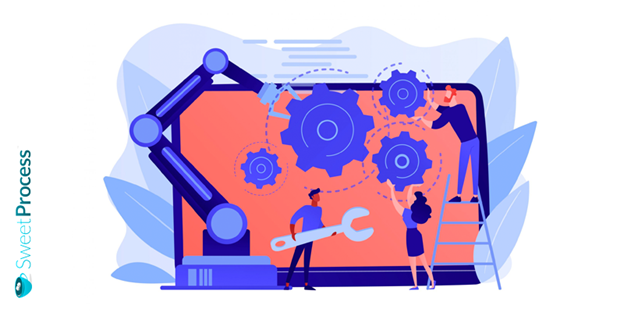
As you may or may not have guessed, performance management is not a matter that concerns only HR. It concerns all leadership levels within an organization.
Nevertheless, many organizations wonder if investing in technology will significantly improve employee performance. Should an organization invest in performance management software, they ask?
Investing in technology will undoubtedly result in considerable improvements only when a particular established performance management strategy is established.
Automated solutions will only overstretch a manager if they don’t access performance management software.
Experts say that if an organization has zero strategic vision, it may fall back to automating only existing processes while missing out entirely on the transformational power that technology brings.
The outcome is a lack of adoption by the leadership and workforce, leading to zero business outcomes.
Employees, including top leadership, are stakeholders who have a lot to benefit from organization-wide implementations of automated performance management systems.
But they must also be aware of the objectives they want to accomplish via performance management.
Performance management data generally offers exceptional insights that no amount of surveys or manual tracking can provide.
Let’s check out the features of effective performance management software.
Key Features of Effective Performance Management Software
Any efficient performance management software should only be chosen if it satisfies the following criteria:
- Customization: The software should be readily customizable to suit your organization’s performance management and industry strategies.
- Transparency: The software should eliminate the general confusion that managers and their teams often experience during performance management.
- Objectivity:The software should offer unique, objective metrics on which managers can evaluate their overall performance.
- Frequency: The software should allow for instant, real-time feedback and occasional employee ratings.
Main Features of a Performance Management Software
Based on the criteria highlighted thus far, an excellent performance management software should possess the following exceptional features:
- Dynamic goal setting:The employees’ objectives should align perfectly with the organization’s goals. It should be possible to change the objective when and as needed.
- Continuous performance evaluation: Managers should use the performance management solution to create a general evaluation and automated self-assessment questionnaires that can be delivered within the flow of work.
This will give the managers a crystal-clear view of how each employee perceives their overall performance on the job. It also reveals whether employees are on track to accomplish the organization’s goals.
- Recognition tools: The performance management solution should come with a platform that gives room for managers to shout their encouragement/approval or share words of motivation to their team members for excellent performance in their day-to-day activities within the organization.
Another excellent feature the performance management solution should have is integrating an email to give instant and direct feedback in real-time. This will also engender positive employee engagement and motivation.
- Communication on the fly: An excellent performance management solution provides seamless interaction between managers and team members at any given time via an integrated chat feature. A quick or brief chat with managers or team members helps keep communication effortless and transparent.
- Scheduling tools: Every good performance management solution should permit team members to schedule and plan meetings, complete assigned tasks, and collaborate extensively with one another. The scheduling tool will be one of the most-used features, especially for employees on the field or those who operate remotely.
- 360-degree feedback: The 360-degree feedback, or feedback from multiple, proven sources, is crucial for highly effective performance management. It minimizes the bias that may arise from the evaluation or assessment of a specific employee by only one individual.
This tool should offer the option of obtaining or collecting feedback from team members, reports, peers, and reporting managers from other teams.
- Project performance tracking tools: The performance management solution should come with integrated tools or features such as timesheets that help track how employees utilize their time. It also helps determine whether the employees’ input matches the expected outcome and output.
Many tools powered by artificial intelligence come with exceptional features such as advanced natural language processing.
This remarkable feature efficiently tracks all project-related keywords via email and other communication channels to measure the progress of a particular project. Such tools enable more objective performance evaluations.
- Performance comparison: It should be possible for managers to track the overall performance of every employee assigned to specific projects or in their team.
The performance management solution should also automatically generate performance reports, providing accurate data on metrics you have already customized to assess.
- Automated reminders and notifications: The ideal performance management solution should come with automated notifications and reminders that give employees and managers gentle nudges to remind them of deadlines.
It should also have features that indicate the progress of a particular project and general updates to changes within the process. These features can significantly boost an employee’s experience with performance management.
- Data security: Every level of granular data about each employee should be heavily safeguarded with a robust firewall set in place. Ensure that all shortlisted tools have a protection feature and robust data security.
Implementing performance management systems is crucial because the employees and managers are well trained to utilize the entire system for maximum efficiency.
Therefore, choose a performance management solution or software from a trusted vendor that provides ongoing support at all times by helping managers and their team members deploy the software optimally.
Which Performance Management Processes Cannot Be Automated?
Performance management is a people-centric process. As employees navigate through work, they would have feedback based on their experience and should relate these to their supervisor or manager.
Although feedback conversations are generally tricky, they can be made easier and turned into coaching sessions and honest discussions when such conversations are heavily supplemented with objective data provided by the performance management system.
The data also helps deal with all implicit biases as every employee knows they are being accessed objectively. This is why managers and employees should effectively utilize all forms of process automation.
Notable Performance Management Tools/Platforms
There are several platforms that you can use to enhance your performance management efforts. Here are some notable performance management platforms or tools in no particular order.
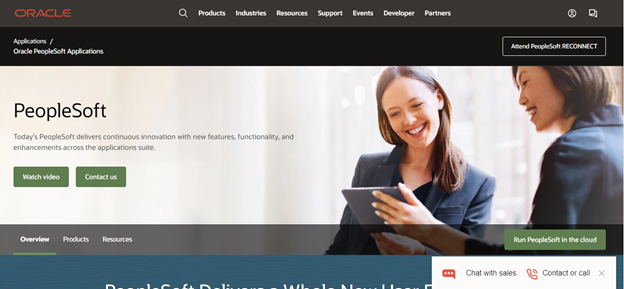
Oracle’s Fusion Applications is the leading seller of this unique performance management solution. It deals with employees’ life cycles for approximately 40 million specialists in 14,000 companies across 40 nations.
This performance management software has integrated modules for payroll, core HR, talent management, collaboration, performance management, and analytics. This makes it easy for a client to complete every HR capacity within one software.
The software also comes with several deployment choices, i.e., SaaS (private or public cloud), a hybrid that offers choices and extreme flexibility to users, on-demand, and on-premise.
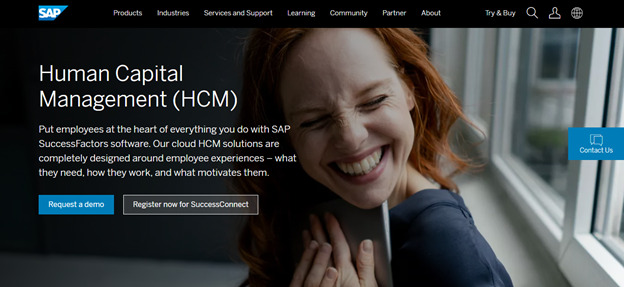
SAP SuccessFactors is all about human resource management in the cloud. It is a prominent cloud HCM suite that utilizes cutting-edge technologies to help businesses win the highly competitive war for top talent and to drive results across businesses, and connect people to true purpose.
Organizations can use SAP SuccessFactors to track recruitment strategies and discover which resources provide the most talented applicants. Organizations use this vital information to formulate all their training strategies so that all employees hit the ground running.
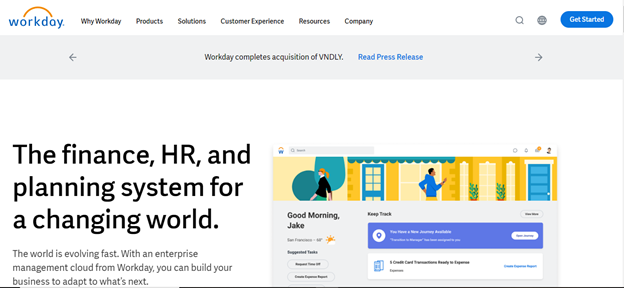
Workday is a renowned HCM software with analytics and real-time reporting features, such as prism investigation, that helps settle on much better business options or choices.
The tool has several application modules like financial performance management, human capital management, and financial management. It is one of the pioneers of software integration and data migration.
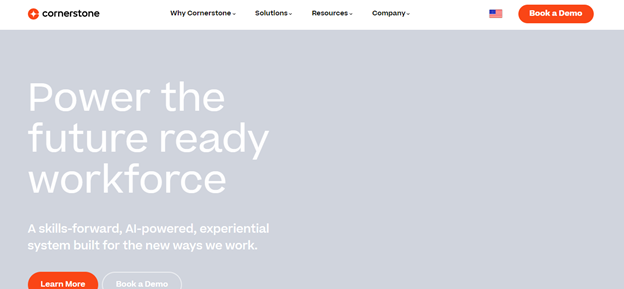
This configurable and powerful platform provides companies with a fully integrated talent management suite. This suite is designed to ensure the organization can effectively recruit, train, and manage its valuable human capital.
Every Cornerstone OnDemand’s solutions are cloud-delivered. Each app is developed in-house via a single code base, giving users only one interface and one support model. It comes with powerful functions such as recruiting, applicant tracking, learning management, onboarding, performance reviews, etc.
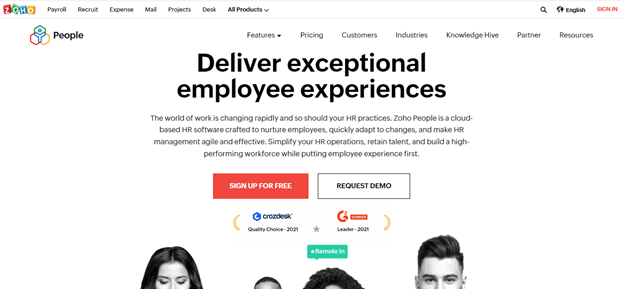
This tool is primarily designed for small and medium-sized businesses. It is an adaptable and basic HCM framework covering every aspect of employee management operations such as records, participation/time, and leave.
Zoho People is the ideal solution for companies that need answers that can be executed swiftly and effectively without tweaking the framework entirely. It is incorporated with the most popular Zoho efficiency frameworks.
The tool accompanies webhooks and open APIs that make it entirely adjustable and adaptable. Zoho People is ideal for tracking employee data, logging hours at work, and following numerous types of downtime.
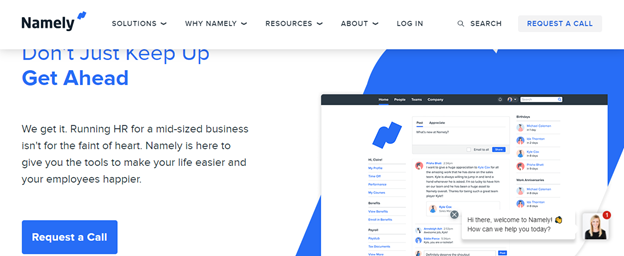
This is a cloud-based HR software designed to provide several resources that make employees happier and life more manageable. This tool comes with modern, intuitive technology that the best HR experts can use to empower people teams with all-in-one HR solutions for mid-sized businesses.
Namely helps organize HR data into one platform via an interface essentially focused on the workforce’s needs. It meets the unique needs of businesses as it is built for flexibility.
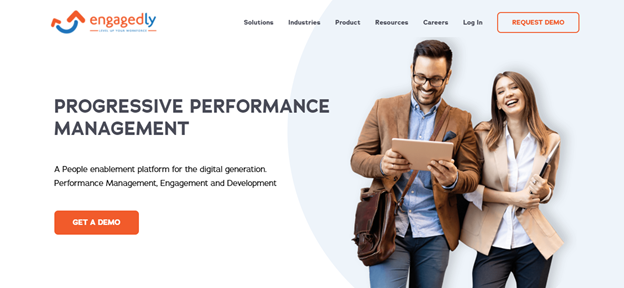
This tool performs like a traditional performance management software by allowing you to schedule performance reviews and create goals. It offers an excellent interface, peer-to-peer feedback, as well as a mobile application to provide real-time feedback to every employee in addition to standard reviews.
Using Engagedly still enables you to use other HR tools as add-ons. It has social learning tools, learning management tools, and allows a nine-box leadership evaluation.
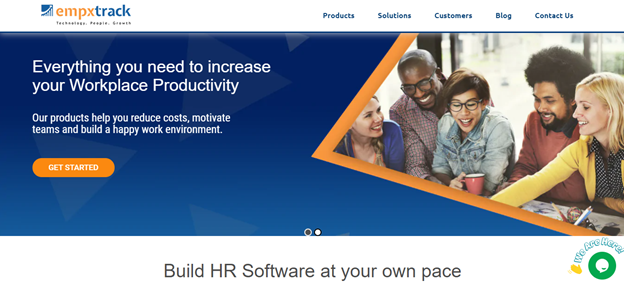
Empxtrack from Saigun Technologies is a customizable HR software that allows users to ensure they are filling their business needs.
It helps in planning performance and recruiting management, controls workflow, grows and even develops employees. It works best for mid-sized businesses and enterprise businesses.
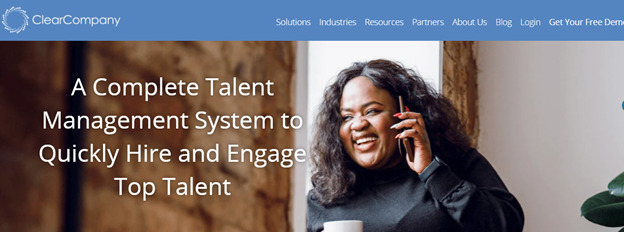
ClearCompany is an HR solution that has enabled thousands of organizations to attract, screen, and hire much better talent efficiently.
It has also helped companies engage teams and utilize strategic insights to keep their recruiting highly competitive.
ClearCompany is a unified platform that supports the entire company during the talent lifecycle with unique cross-platform analytics only available when one standard system captures data.
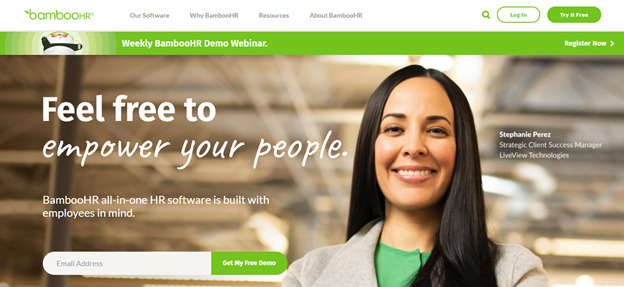
BambooHR is a tool used as a target toward SMSs. It offers HCM software that comes with an applicant tracking system (ATS) as well as a wide variety of HEIS apparatuses to deal with every part of an employee’s lifecycle.
BambooHR has an open API that enables the tool to be incorporated into any company’s current HR tech sellers.
The software has a performance review function that is suitable to how more companies are working nowadays.
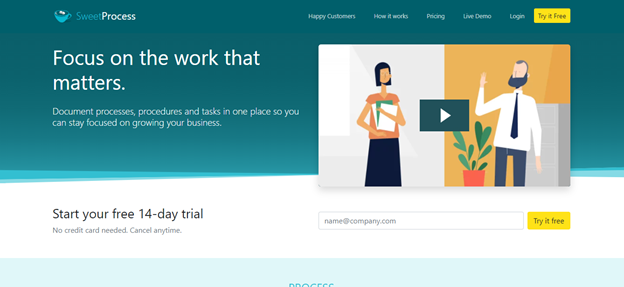
SweetProcess is a well-known platform for making the documentation of standard operating procedures more efficient and easy so clients can stay entirely focused on their businesses.
It allows businesses to empower members of their teams to carry out their jobs accurately by documenting all tasks within a single place to prevent repetitive emails.
The platform also helps organizations create and ensure the proper adoption of all business policies.
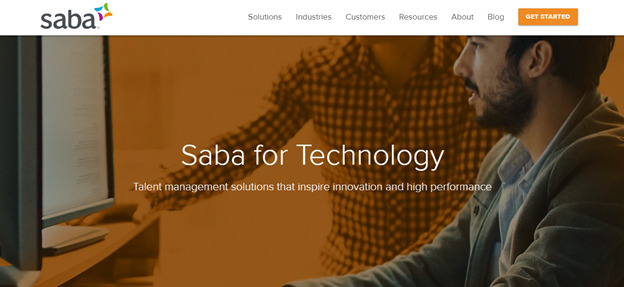
Saba Cloud HCM software provides a cloud-based talent management solution that over 31 million clients in worldwide utilize and access via 37 distinct dialects. Saba can be portrayed as a complete human resources management solution.
It can be customized to suit any organization and is effectively adjustable. Saba can also be received on a module-by-module basis or premise. The modules incorporate planning, execution, hiring, compensation, progression, and eLearning.
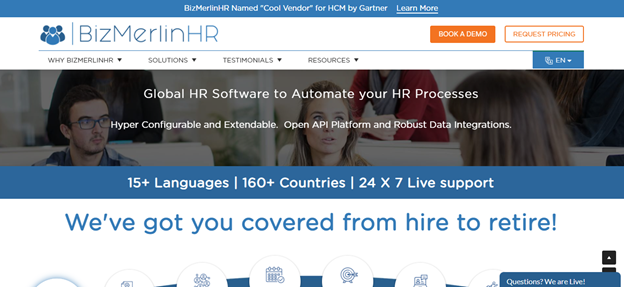
This online or cloud-based HCM software offers onboarding tools, leave tracking, employee records, e-signature, performance reviews, goal tracking, 360-degree feedback, reporting, succession planning, and applicant tracking system.
BizMerlin is available via native Android and iOS mobile applications and browsers. It comes with configurable performance review features that allow managers to easily consolidate employee evaluations and align all their objectives with corporate strategy.
Choosing the Best Performance Management Software
To choose the best performance management software, the number one thing you need to do is to fully understand all your performance management needs, processes, and resources. Be as honest as possible about how tech-savvy your organization is.
For instance, is there an in-house, tech-savvy IT support team, or will you need to outsource or hire a freelancer or support from a performance management tech vendor?
Next, develop a checklist of performance management tool capacities. This is only possible after carefully articulating precisely where you are with your resources and program. This helps you focus on what your organization needs.
An example of a checklist you can create include:
- Job descriptions
- Opening or hiring management
- Performance appraisals
- Key performance indicators
- 360 feedback
- Performance reviews
- Independent development plans
- Employee engagement
This is the checklist that will inform your decision to choose a specific performance management software suitable for your business.
What is the Future of Performance Management?
Performance management, as a practice, is currently bordering on learning, career management, and engagement.
Yearly performance management is fast going out of fashion
As the conception of performance management continues evolving, so do nearly all the practices linked with it. For example, many organizations globally, such as Netflix, have ditched yearly performance management practices. They now implement what is referred to as “fluid performance management,” i.e., a continuous and agile approach to efficiently managing performance.
Performance management tech is prevailing or becoming more established
Artificial and cognitive intelligence, as well as smart machines from a technology point of view, are expected to be more prevalent these days and in the future.
This includes capabilities that can zealously recommend engagement suggestions and performance actions to better complete individual objectives.
There will eventually be more advanced utilization of capabilities that provide seamless user experience instead of different systems that build performance activities into the same systems where work is genuinely getting done.
Person-to-person feedback is gaining more significance
Replacing yearly performance management for fluid performance management does not do away with the profound need for person-to-person feedback.
If truth be told, it enhances the importance of frequent feedback to make sure every employee’s work aligns with the organization’s goal. Managers can even coach employees and fine-tune workflows to facilitate the rapid achievement of goals.
These insights reveal the crystal-clear key takeaway for HR teams. When managers with people skills align with an efficient performance management system that delivers regular feedback, it creates a highly motivated workforce. This translates to significantly improved business outcomes.
Chapter 5: How SweetProcess Can Enhance Your Performance Management Process

Managing employee performance can be a daunting task. You need to keep track of goals, objectives, feedback, and reviews—not to mention the day-to-day tasks that employees are responsible for.
It can be hard to stay on top of everything, especially if you’re trying to do it all by yourself. Juggling employee performance with the rest of your work can feel impossible.
Without a proper system in place, it’s easy for important tasks to fall through the cracks. Important conversations may not happen, or they may happen too late. This delay can lead to employees feeling unsupported and unmotivated.
SweetProcess is here to help. This online performance management software makes it easy to track employee progress, set goals and objectives, and provide feedback.
With SweetProcess, you’ll have more time to focus on your business—and less time worrying about performance management.
We all know that clutter can cause much stress. It’s not only hard to find things when they are in disarray, but it can make you feel like you need more time and space than is realistically available.
But what if we could cut the clutter and improve our performance? That’s what Ben Hendershot, the chief operating officer at Altvia, did with SweetProcess.
Altvia found that their employees were spending over 20 minutes each day trying to find information or tools on their desktops, causing them to lose focus and be less productive.
They needed a system to allow employees to quickly access the items they needed without being overwhelmed by an abundance of other files or applications on their computer screens. The company turned to SweetProcess for help.
They were able to transform their business and better equip their employees to become more productive.
Optiable was struggling with their outdated process of putting out content, but after implementing SweetProcess, they saw significant improvement in their productivity.
“We used to have many issues with people not being able to get on the same page,” said Susanne Menges, chief operating officer at Optiable. This lack of clarity translated into missed deadlines and less output overall.
After implementing SweetProcess, she and her team are more productive because they can work better together.
She also appreciates that all employees can see what everyone is working on when using the software tool.
Now that Optiable has incorporated SweetProcess as a solution, it has helped them communicate better to produce content faster while maintaining high-quality standards.
In 2017, ClickFunnels had a hyper-growth phase. To keep up with the demands of their customers, they needed an internal communication tool that was quick and efficient. Clayton Panzeri, the senior customer service lead, ensured that he covered customer issues without overwhelming his staff.
With SweetProcess, ClickFunnels tripled productivity and saved 30% of work time by eliminating back-and-forth communication due to automation features in the software.
Currently, over 400 teams are using SweetProcess at ClickFunnels, including support teams for marketing and sales departments.
SweetProcess is quite versatile and can differentiate between retaining talent and experiencing high turnover in your business. You can take it for a spin using the 14-day FREE trial to see it in action.
Take the right step and begin to reward performing employees with the right performance management system starting today!
Conclusion
Performance management is a systematic process that monitors and supervises specific departments or employees’ roles to ensure they meet and achieve all organizational goals efficiently and effectively.
If you have not been implementing performance management the right way, now is the time to start. Take advantage of the 14-day FREE trial to make the process seamless for your organization.
By implementing performance management in your organization, you can improve communication, optimize productivity, and increase overall employee satisfaction.
Have you been using the right platform for your performance management? How has it been thus far? Share your experience with us in the comments!

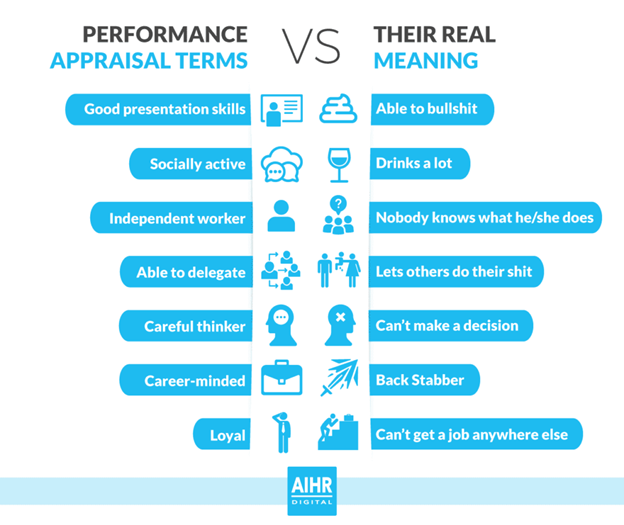
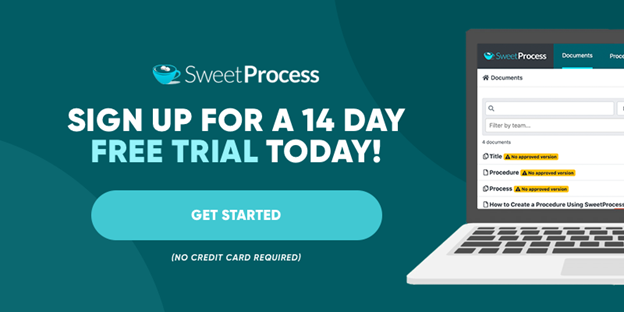




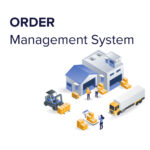



Leave a Reply